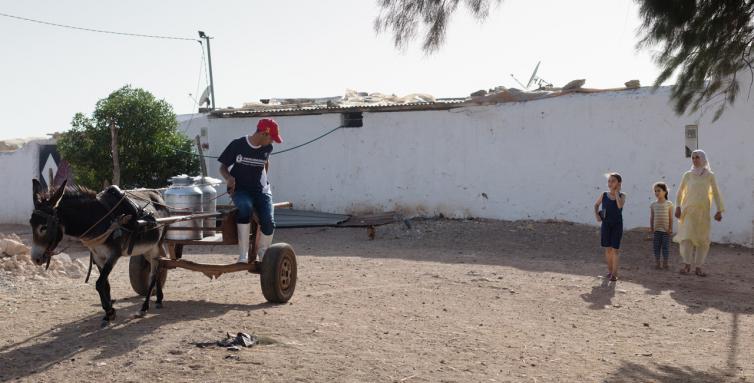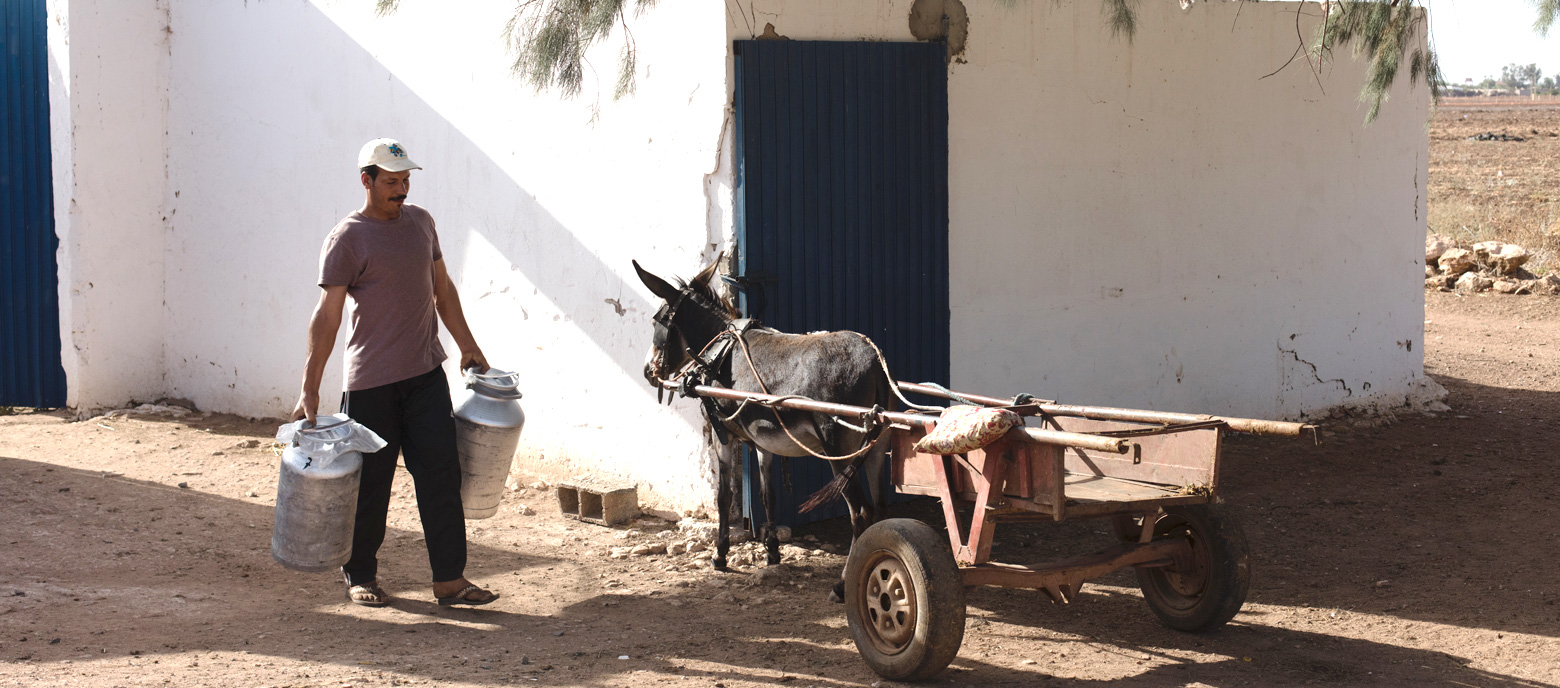Higher quality
Milk for Morocco
The scorched air of the Moroccan summer shimmers above the dusty fields surrounding the farmstead of Moustapha al Horch. Three dogs with watering eyes keep guard. Al Horch’s jeans are tucked into the top of his white rubber boots, the face beneath a baseball cap is tanned by the sun. He is only just taller than his finest cow, a Friesian imported from Germany. The small-scale farmer owns four dairy cows and recently acquired five heifers – young cows that have not yet calved – and three calves. He hopes that will be sufficient to provide for his family. He and his wife, Nedia al Horch, already have two daughters, with a third child on the way.

Al Horch is a member of a farmers’ cooperative. GIZ in co-creation with Centrale Danone is helping farmers not only to improve the quality of their milk, but also to boost their income at the same time. The project is financed by the Danone Ecosystem Fund, founded by the food corporation of the same name, with just under EUR 1 million provided in the first two years. Danone’s Moroccan head office will contribute EUR 267,731, the milk collection points a further EUR 166,232 that are part of the project. The project is planned to run for five years in total. Danone’s interest is to increase the volume of milk it gets from indigenous farmers while maintaining high quality, with a view to processing it in Morocco while supporting smallholders in developing and creating social value in the ecosystem it operates. The project was launched in mid 2015 in the Chaouia region surrounding Casablanca, where seven agricultural technicians oversee 33 milk collection points and share responsibility for around 1,500 farming families. With two other regions set to join the project, altogether 77 cooperatives and 10,000 dairy farmers will eventually enjoy the benefits.
More and more people abandon rural areas
As more and more people abandon rural areas in Morocco, the country’s towns and cities are growing exponentially. Al Horch moved in the opposite direction: he left the city to return to the farmstead of his grandparents. Now 49, al Horch grew up in Casablanca, his parents having moved to Morocco’s largest city before he was born. On leaving school, he took a course in information technology, but never really found much enjoyment in the subject. ‘It wasn’t until I came here that I actually found peace. I love working in agriculture. And now I’ve even discovered the knack of how to deal with cattle.’
Over a century ago, his father’s grandfather was the first person in the region to build a solid house. ‘The oldest room dates back to 1896. In those days the neighbours still lived in tents.’ Some of the family was still living in the village when al Horch decided to become a farmer. For most of the other farmers in his cooperative it had never been a matter of choice. Despite this, al Horch is now one of them.
Milk to be chilled as soon as possible
The evening draws in – it is milking time and the cows’ udders look full to bursting. The darkened cowshed is filled with a low, loud mooing. Al Horch wheels in the mobile milking machine. After carefully washing and drying the cows’ teats, he squeezes a few drops of milk from each one onto the ground. Everything is now ready. With the four red teat cups firmly attached to the udder, the tubes quickly fill with fresh milk. The yield is 44 litres. It’s always a little less in the evening than in the morning, al Horch explains. But the concentration of nutrients is higher. As soon as the job is done, he sets off with his donkey to the cooperative’s milk collection point. The sooner the fresh milk reaches the cooling tank the better.
The farmers are now having to get used to one of the new rules introduced by the project: since milking takes place twice a day, milk must also be delivered to the cooperative twice a day in order to be chilled as soon as possible after milking and keep its bacteria count level low. And that is not the only strict control in place. Once the milk arrives at the collection point, it first has to undergo content testing for fat, protein and bacteria. Any farmer whose milk fails to meet the quality criteria is required to take it home again.
Solar module on the roof for warm water
Much has changed at the cooperative since the launch of the project. The farmers have renovated the milk collection point, equipped it with tiles and modern instruments for quality testing, and installed a solar module on the roof for warm water. Although Danone has undertaken to shoulder the bulk of the costs, a fundamental aspect of the project requires the cooperative to contribute to finances, so that members take responsibility for the innovations themselves. The farmers who benefit from the project pledge to sell their milk to cooperative to ensure its revenue and sustainabilty . In return, the cooperative will not apply a cap on supply volumes, which would otherwise pose a problem to farmers in particularly productive phases. In addition, agricultural technicians have briefed members of the cooperative on the key rules of sustainable livestock and dairy farming. These focus on animal feeds, hygiene, breeding and health.
Dairy farmer al Horch is constantly looking for ways to make his small-scale business more profitable. To begin with he looked to other sources of income and grew potatoes, for example. But for the last few years he has focused on his dairy herd: ‘It’s important to do whatever you do well. So I believe it’s best to decide on one area and become a real expert at it.’ He is already looking forward to the next training course. When the project was launched, the fat content of the cooperative’s milk rose significantly. So farmers earned on average eight per cent more – because the higher the fat and protein content, the higher the price.
Keeping the quality level
Despite that, it occasionally happens that some farmers are unable to sell their milk. Moustapha al Horch is one of them. ‘I had problems at the end of June, when the fat and protein content of my milk was too low. The problem was the heat, which caused the cattle a lot of discomfort. To some extent it was also the poor quality of the feed. My supplier stored it for too long. For a week all I could do was put the cows on a diet and feed them straw. Now my milk quality is back to what it was.’ The measuring device at the collection point today reads 39 grams of fat per litre – outstanding figures. Al Horch beams.

![]()
![]()
![]() Picture gallery: Milk of higher quality for Morocco
Picture gallery: Milk of higher quality for Morocco
Today there is another issue that needs addressing. With the first harvest of the summer already in, farmers who buy feed now for the months ahead can make long-term savings. Supply is currently high, prices are low. But most small farmers do not have the money to buy in large quantities. For this reason, the project also provides interest-free loans which the farmers can pay back in kind – with milk. This approach enables them to cut the cost of feed by over one sixth.
Research alternatives to maize as feed for livestock
But the project also supports individual crop farms. Project staff are currently working with farmers to research alternatives to maize. For although this makes a very suitable feed for livestock, growing it at all in Morocco requires a lot of water.
Moustapha al Horch has even taken out an additional loan to finance the acquisition of four new heifers. He has to have paid off the loan with his milk within 21 months. With the state shelling out 5,000 dirham for each heifer, al Horch’s debts for the new animals total 88,000 dirham – a little over EUR 8,000. It’s a considerable sum of money for a dairy farmer like him. But he is confident that his investment in the future is sound.
Contact: Natalia Duguy > nathalie.duguy@giz.de
January 2017
LONG TERM VISION
